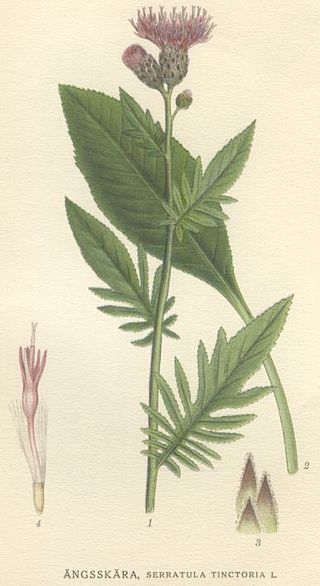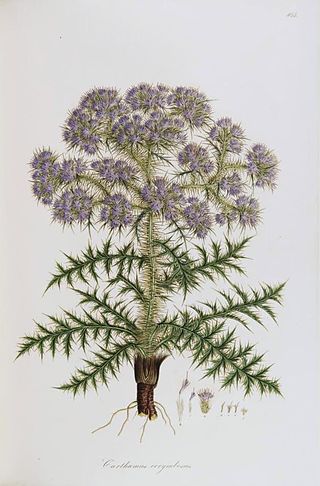
Asteraceae is a large family of flowering plants that consists of over 32,000 known species in over 1,900 genera within the order Asterales. The number of species in Asteraceae is rivaled only by the Orchidaceae, and which is the larger family is unclear as the quantity of extant species in each family is unknown. The Asteraceae were first described in the year 1740 and given the original name Compositae. The family is commonly known as the aster, daisy, composite, or sunflower family.

Cynara is a genus of thistle-like perennial plants in the family Asteraceae. They are native to the Mediterranean region, the Middle East, northwestern Africa, and the Canary Islands. The genus name comes from the Greek kynara, which means "artichoke".

Carlina is a genus of flowering plants in the family Asteraceae. It is distributed from Madeira and the Canary Islands across Europe and northern Africa to Siberia and northwestern China.

The genus Carthamus, the distaff thistles, includes plants in the family Asteraceae. The group is native to Europe, North Africa, and parts of Asia. The flower has been used since ancient times in the Philippines, which it has been called kasubha by the Tagalog people.

Ptilostemon is a genus of plants in the tribe Cardueae within the family Asteraceae.

The Cardueae are a tribe of flowering plants in the daisy family (Asteraceae) and the subfamily Carduoideae. Most of them are commonly known as thistles; four of the best known genera are Carduus, Cynara, Cirsium, and Onopordum.

Rhaponticum is a genus of flowering plants in the tribe Cardueae within the family Asteraceae. As of November 2023, it is accepted by Plants of the World Online, but rejected by the Global Compositae Database in favour of Leuzea.

Serratula is a genus of plants in the tribe Cardueae within the family Asteraceae native to Eurasia. Plumeless saw-wort is a common name for plants in this genus. Serratula as traditionally defined contains at least two groups: one of which is basal within the subtribe Centaureinae and one of which is derived; the former group can be moved to the genus Klasea.
Centaurodendron is a genus of flowering plant in the tribe Cardueae within the family Asteraceae. The entire genus is endemic to the Juan Fernández Islands in the southern Pacific Ocean, part of the Republic of Chile.

Crupina is a small genus of plants in the tribe Cardueae within the family Asteraceae.
Carthamus creticus is a plant species in the family Asteraceae, related to safflower.
Oligochaeta is a genus of Asian flowering plants in the tribe Cardueae within the family Asteraceae.

Alfredia is a genus of flowering plants in the tribe Cardueae within the family Asteraceae described as a genus in 1816.

Amberboa is a genus of flowering plants in the tribe Cardueae within the family Asteraceae, described as a genus in 1832.

Tugarinovia is a genus of East Asian flowering plants in the tribe Cardueae within the family Asteraceae.

Tyrimnus is a genus of Mediterranean plants in the tribe Cardueae within the family Asteraceae. The only known species is Tyrimnus leucographus, native to the Mediterranean region of southern Europe, North Africa, and the Middle East.

Staehelina is a genus of Mediterranean flowering plants in the tribe Cardueae within the family Asteraceae.
Russowia is a genus of Asian flowering plants in the tribe Cardueae within the family Asteraceae. The only known species is Russowia sogdiana, native to Kazakhstan, Kyrgyzstan, Xinjiang, Tajikistan, Uzbekistan, Afghanistan and Turkmenistan.

Berardia is a monotypic genus of flowering plants in the tribe Cardueae within the family Asteraceae, containing the single species Berardia subacaulis. It is an alpine plant native to the Alps mountain ranges.

Cardopatium is a genus of flowering plants in the tribe Cardueae within the family Asteraceae. They are native to the central and eastern Mediterranean region.
















